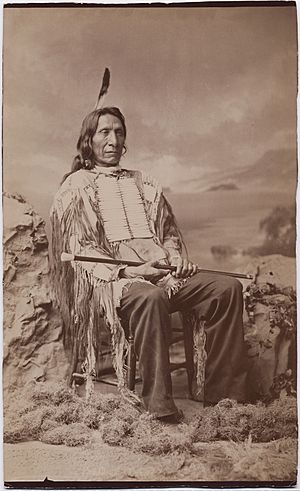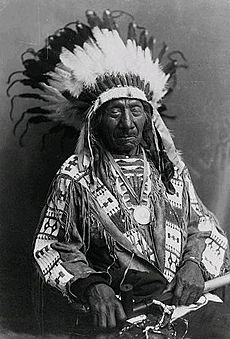Red Cloud facts for kids
Quick facts for kids
Red Cloud
|
|
|---|---|
| Maȟpíya Lúta | |

Red Cloud in 1880
|
|
| Born | 1822 near North Platte, Nebraska, US
|
| Died | December 10, 1909 (aged 86–87) |
| Burial place | Red Cloud Cemetery, Pine Ridge |
| Nationality | Oglala Lakota |
| Known for | Red Cloud's War Most photographed American Indian of the nineteenth century |
| Title | Tribal chief |
| Successor | Jack Red Cloud |
| Spouse(s) | Pretty Owl (Mary Good Road) |
| Children | 6 |
Red Cloud (Lakota: Maȟpíya Lúta) was an important leader of the Oglala Lakota people from 1868 to 1909. He was one of the strongest Native American leaders the United States Army faced in the western parts of America. He famously won a conflict against the United States called Red Cloud's War. This war was fought over control of the Powder River Country in what is now Wyoming and Montana.
After the war, Red Cloud signed a peace agreement called the Treaty of Fort Laramie (1868). He then helped his people adjust to living on a reservation. Some people mistakenly thought he was the main leader of all the Sioux groups. However, the Lakota people were made of many different groups, and each group had its own leaders. Red Cloud was highly respected as a warrior and leader among his own Oglala people.
Contents
Early Life of Red Cloud
Red Cloud was born in 1822 near the Platte River in what is now North Platte, Nebraska. His mother, Walks as She Thinks, was Oglala Lakota. His father, Lone Man, was a leader of the Brulé Lakota. These were two of the main groups within the larger Lakota nation.
The Lakota people traditionally followed their mother's family line. Because of this, Red Cloud was guided by his mother's uncle, Old Chief Smoke. Old Chief Smoke was a very important person in Red Cloud's childhood. He took Red Cloud into his home around 1825 after Red Cloud's parents passed away. From a young age, Red Cloud fought against neighboring tribes like the Pawnee and Crow. This gave him a lot of experience in battle.
Red Cloud's War: Fighting for Land
Red Cloud's War was a series of battles between Native American Plains tribes and the U.S. Army. These fights took place in the Wyoming and Montana areas from 1866 to 1868. The Northern Cheyenne, Lakota, and Arapaho tribes worked together against the Army.
A major event in this war was the Fetterman Fight in December 1866. Native American warriors attacked and defeated a U.S. Army unit. This battle resulted in the most U.S. Army deaths of any Plains battle up to that time.
The Fetterman Fight
Captain William J. Fetterman led 81 U.S. soldiers from Fort Phil Kearny. They were sent to chase away a small group of Native American warriors. Captain Fetterman and his second-in-command, Captain Frederick Brown, were very confident. They ignored orders to stay close to the fort.
They chased a small group of warriors, including the famous warrior Crazy Horse, who was acting as a decoy. Fetterman and his troops followed the decoy into a trap. More than 2,000 Sioux, Cheyenne, and Arapaho warriors were waiting in ambush. The Native American forces lost only 14 warriors, but they killed all 81 U.S. soldiers.
After this big defeat, the U.S. government sent a peace group to the Plains in 1867. They wanted to understand why the fighting was happening. They found that Native Americans were upset because white settlers were moving onto their lands and using their resources. The group suggested setting aside specific areas for the Plains tribes.
The Lakota, Northern Cheyenne, and Arapaho tribes agreed to peace with the U.S. government. This agreement was called the Treaty of Fort Laramie. In this treaty, the U.S. agreed to leave its forts and completely withdraw from Lakota territory.
The Treaty of 1868
The 1868 treaty created the Great Sioux Reservation. This large area covered land west of the Missouri River in present-day Nebraska and parts of South Dakota. Even with the treaty, relations between the growing United States and Native Americans remained difficult.
In 1870, Red Cloud traveled to Washington D.C. He met with government officials, including President Ulysses S. Grant. He wanted to discuss the problems his people were facing.
In 1871, the government set up the Red Cloud Agency near Fort Laramie. This agency was a place where Native Americans could receive government aid. Red Cloud moved his people to the agency. However, the aid they received was often less than promised and of poor quality.
According to Charles A. Eastman, Red Cloud was the last to sign the treaty. He refused until all U.S. forts in their territory were removed. All his demands were met. The treaty clearly stated that the Black Hills and Big Horn areas were Native American land forever. It also said no white person should enter without the Sioux's permission. However, soon after the treaty was signed, gold was found in the Black Hills. Many people then wanted to "Remove the Indians!" The government did not seriously try to stop people from breaking the treaty.
The Great Sioux War of 1876–1877
Red Cloud and his group settled at the agency by the fall of 1873. He soon had disagreements with the new Indian agent, Dr. John J. Saville.
In 1874, Lieutenant Colonel George Armstrong Custer led a scouting trip into Sioux territory. He reported finding gold in the Black Hills. This area was considered sacred by the local Native Americans. The army had tried to keep miners out, but the risk of violence grew.
In May 1875, Red Cloud and other Lakota leaders like Spotted Tail went to Washington. They tried to convince President Grant to honor the treaties. They wanted him to stop miners from entering their lands. Grant offered to buy their land for $25,000 and move them to Indian Territory.
Even though Red Cloud tried to find a peaceful solution, he did not join the Lakota War of 1876–1877. This war was led by other famous leaders like Crazy Horse and Sitting Bull.
In the fall of 1877, the Red Cloud Agency was moved. The next year, it was moved again to what is now South Dakota. It was renamed the Pine Ridge Indian Reservation.
Red Cloud's Later Life
Red Cloud became a key leader during a difficult time for the Lakota. They were moving from a free life on the plains to living on reservations. His visits to Washington, D.C., showed him how many European Americans there were and how powerful they were. He believed the Oglala people needed to seek peace.
Around 1880, he visited the scientist Othniel Charles Marsh in New Haven, Connecticut. Marsh had visited the Red Cloud Agency earlier. He reported that Native Americans were suffering because they were cheated out of food and supplies.
In 1884, Red Cloud and his family became Catholics. He was baptized by Father Joseph Bushman.
Red Cloud continued to fight for his people, even on the reservation. In 1887, he spoke out against the Dawes Act. This law broke up tribal lands and gave small plots to individual families. The U.S. government then sold the remaining tribal lands to settlers. In 1889, Red Cloud also opposed a treaty to sell even more Lakota land. Because of his strong stand, government agents sometimes used unfair methods to get signatures for treaties, even from children.
Red Cloud passed away in 1909 on the Pine Ridge Reservation. He was 87 years old and lived longer than almost all the other major Lakota leaders from the Indian Wars. He was buried in a cemetery there that now carries his name. In his old age, he famously said, "They made us many promises, more than I can remember. But they kept but one – They promised to take our land ... and they took it."
Legacy and Honors
News of Red Cloud's death and his achievements were shared in major newspapers across the country. Many articles, like the one in The New York Times, mistakenly called him the leader of all Sioux tribes. However, they did recognize his skills as a leader and diplomat. While he was a very important leader, the Lakota people did not have one single overall leader.
Red Cloud was the most photographed Native American of the 1800s. There are 128 known photos of him. He was first photographed in 1872 in Washington D.C. by Mathew Brady. This was just before he met President Grant. He was also photographed by Edward S. Curtis.
In 2000, he was chosen to be part of the Nebraska Hall of Fame. The United States Postal Service honored him with a 10-cent postage stamp in the Great Americans series.
In 1871, the town of Red Cloud, Nebraska was named after him.
Descendants of Red Cloud
Red Cloud's family members have continued to be chosen as traditional leaders of the Lakota people:
- Jackson "Jack" Red Cloud (1858–1918): Leader of the Oglala Lakota from 1909 to 1918.
- James Henry Red Cloud (1877–1960): Leader of the Oglala Lakota from 1918 to 1960.
- Charles Red Cloud (1884–1980): Brother of James Henry Red Cloud, leader from 1960 to 1979.
- Oliver Red Cloud (1919–2013): Son of Charles Red Cloud, leader from 1979 to 2013. He was a direct descendant of Red Cloud and a speaker for the traditional Lakota Sioux Nation.
See also
 In Spanish: Nube Roja para niños
In Spanish: Nube Roja para niños
Images for kids
-
Othniel Marsh and Red Cloud in New Haven, Connecticut, around 1880.










